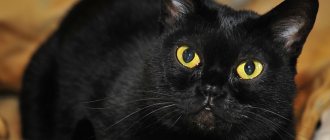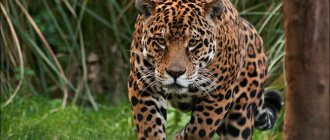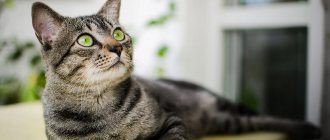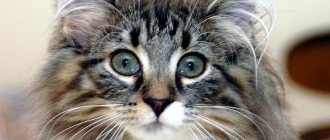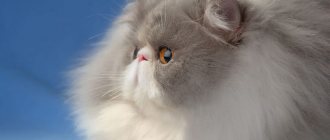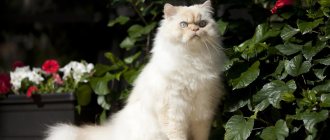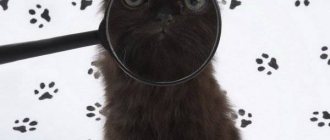Description
The golden cat is a robust member of the feline family, with short, stocky limbs adapted for hunting in trees. Body weight varies from 3 to 18 kg. Males often weigh 11-14 kg. The length of the body from the nose to the base of the tail ranges from 61 to 102 cm. Males tend to be longer, averaging 74 cm, while females have a body length of about 71 cm. The tail reaches a length of 16-46 cm, averaging in males it is 31 cm, and in females it is 30 cm. Height at the withers is from 40 to 50 cm.
Golden cats can vary dramatically in coloration, with coat colors ranging from bright orange to reddish brown. Grayish cats have also been observed. Some individuals have spots on their body. There are melanists - golden cats of black color. The outside of the ears is usually dark in color. White spots are partially located above the eyes. The neck, chest and belly may be light colored and sometimes white. The tail has a dark tip, and there are many small dark spots on the sides and back. One individual at London Zoo went from brownish-red to gray in 4 months, suggesting that a golden cat's fur color can change throughout their life.
There are two subspecies of the golden cat, and they differ slightly in appearance. The subspecies (C. a. celidogaster) or (C. a. cottoni) lives in the Guinea woodland and is either completely spotted or with spots on the neck and sides. Individuals of the subspecies (C. a. aurata) are found east of the Congo River and have spots on the belly and lower sides. In the “hybrid” zone between Cameroon and Gabon, both spotted and unspotted African golden cats can be found.
Number of species
The number of African black-footed cats according to the CFA (Cat Fanciers' Association) is extremely small. The number of wild individuals has not been calculated even approximately. There are only 40 such animals in all zoos in the world, of which 19 are in the United States.
The number of black-footed cats is very small
There is no targeted hunting for this species, but animals die accidentally as a result of falling into traps set for other predatory animals. Hybridization with domestic cats also threatens the natural population. The degradation of the species was caused by environmental reasons and changes in the natural environment. However, a special program has been developed for breeding the African spotted cat in captivity, which is supported by several zoos. Over time, biologists expect to increase the number of animals and gradually restore the population.
Servals, like other exotic animals, are targeted by poachers. Firstly, the fur of spotted cats is always in demand. And secondly, Africans hunt cats for their meat. In addition, predators are exterminated due to attacks on poultry. For these reasons, the number of the species is declining every year.
Serial is a medium-sized African wild cat. Servals lead a predominantly crepuscular lifestyle, feeding on small animals. Servals are smart and inquisitive. They are capable of remembering and learning, which is why people learned to domesticate these cats.
Area
The geographic range of African golden cats stretches across equatorial Africa. They inhabit areas ranging from the wooded savannas of western Sierra Leone to primary forest areas of central Africa and, as far east as Kenya. The Congo River provides a natural geographic barrier separating the two subspecies.
Habitat
Although golden cats can be found in a variety of habitats, they prefer heavily forested areas. Caracal aurata adapt well to areas with dense secondary undergrowth, which is an advantage for camouflaged hunting. Waterways at the edges of the home range leading into savannah woodlands are sometimes considered preferred habitat areas due to the dense populations of rodents living nearby. Individuals of this species have been recorded at altitudes up to 3600 m in the mountains of Uganda and the Aberdare mountain range in Kenya. Although there is no confirmed evidence, it is reported that the golden cat may also live in montane and lowland rainforests.
The history of the Temminki cat
Golden Asian cats were first discovered in the late 19th century by Dutch explorer Conrad Jacob Temminck. The species itself was named after this scientist.
This discovery is unusual, since the zoologist believed that he had met African golden cats in the Asian forests and it was precisely how Temminok first described these animals.
Today this predator has several names - Asian Golden, Temminka's Cat, Fiery, Fire Cat.
In its morphology, the animal is very similar to a puma, although much smaller and of a different color.
Reproduction
There is little information about the breeding system of African golden cats. There has only been one recorded case of two wild individuals traveling together. This information suggests they may be monogamous, but more evidence is needed to fully understand their breeding system.
All current information about golden cat breeding is based on observations of animals in captivity. The number of cubs in the litter varies from 1 to 2, rarely 3. Pregnancy lasts 75-78 days. At birth, kittens weigh from 195 to 235 g. They are born blind, and open their eyes after approximately 1 week. At 2 weeks of age, they become curious about their surroundings. Weaning from mother's milk begins around 6 weeks. Males reach sexual maturity at the age of 6 months, while females reach sexual maturity at 11 months.
Little information is known about the parental care of African golden cats, although mothers provide essential care to their young for a period of time. Kittens will probably never travel on their own until puberty.
Is it possible to keep Temminka at home?
The Temminck cat is a wild animal, its temperament is not suitable for domestic living and it is practically impossible to tame and socialize due to its fearfulness and caution.
Currently, only a limited number of individuals are kept in zoos, nature reserves and specialized nurseries.
In Russia there are only two cats of different sexes in the Novosibirsk Zoo. It is noted that the individuals living in the enclosure allocated for them do not show any aggression towards the workers, but they are not interested in humans, do not strive for communication, they are calm and restrained in behavior.
Rare breeders note that even a kitten raised in captivity and weaned from its mother early as an adult should be kept only in a spacious enclosure, as it can be dangerous to humans.
With puberty, all the instincts of a predator awaken in a cat and, although the pet will never attack first, it is impossible to predict its behavior.
Perhaps over time, when several generations of these rare cats can be obtained in captivity, it will be possible to obtain hybrid varieties of Temminki that will be prone to socialization. After all, such experiences in the conditions of foreign breeding are not uncommon. These are the well-known Bengals (with the wild Bengal cat), Chausie (with the reed or swamp house cat), and Caraquets (with the caracal).
Communication and perception
Aggressive behavior has been observed in captive specimens. When they feel threatened, they arch their back slightly and the fur on their back and tail rises perpendicularly. The head is lower than the body, and, as a rule, tilted to one side. The curved tail resembles a hook; The cat can hit it sharply and then return to its original shape. When African golden cats attack, they move quickly and confidently, rather than circling like caracals, pumas or leopards.
Feeding
Temminck's cat is a typical medium-sized predator that, under natural conditions, feeds only on living protein foods. Its prey is usually animals belonging to the following species:
- rodents – rats, mice, gophers;
- hyrax;
- monkeys;
- wild goats;
- small antelopes;
- amphibians and reptiles;
- birds.
Especially large male Temminki even attack buffalo and deer, domestic sheep and calves.
In zoos or home enclosures, these cats should also be fed only fresh raw meat; preference is usually given to poultry, live rodents, and rabbits.
Nutrition
The golden cat is a carnivore and preys on medium-sized mammals such as tree hyraxes, red duikers, small forest antelopes, monkeys, and in some cases feeds on birds and fish. Based on excrement, small rodent species weighing less than 300 g are considered the mainstay of the diet. Cats of this species have been recorded as capable of hunting some monkeys, but they are believed to attack fallen or injured monkeys. The short and strong limbs of the golden cat provide an advantage in arboreal hunting, although this has only been recorded a few times. The golden cat often removes feathers from birds before consumption.
Wild cat diet
The Temminck cat is a typical predator, so its main food is fresh meat. The animal hunts mainly large birds, gophers, rats and other rodents, but its diet may also include large species of reptiles and amphibians and even insects. In addition, young specimens of artiodactyl mammals (young deer, etc.) often become the food of this predator.
Did you know? The international name Temminck's cat was given by the British scientist and naturalist Thomas Horsfield in 1827.
Security status
The golden cat is classified as Near Threatened by the IUCN. Recent reports indicate that African golden cat populations are declining, largely due to habitat deforestation. Hunting also plays a minor role in reducing animal populations. Hunting restrictions have been enacted in the following countries: Angola, Benin, Burkina Faso, Republic of the Congo, Ghana, Cote d'Ivoire, Kenya, Liberia, Nigeria, Rwanda, Sierra Leone and the Democratic Republic of the Congo. The golden cat is listed on Appendix II of the Convention on International Trade in Endangered Species (CITES).
Purchasing a Temminka kitten
This animal is now listed in the first CITES appendix, and smuggling is subject to a large fine and even imprisonment. Even large zoos find it difficult to acquire these rare and unique animals.
Only from single foreign breeders, with a long and persistent search, can you find “legitimate” kittens born from cats who themselves grew up in captivity and have all the necessary documents about their origin.
The cost of a kitten starts from 7-10 thousand dollars.
In order to seriously engage in breeding the Temminka Cat and its hybrid species in captivity, a person, first of all, needs to restore the natural population and stop the extinction of this rare animal.
For this purpose and to stop the deforestation of rare tropical forests, various associations have been created, including the World Conservation Organization, which includes a number of government and public companies.

